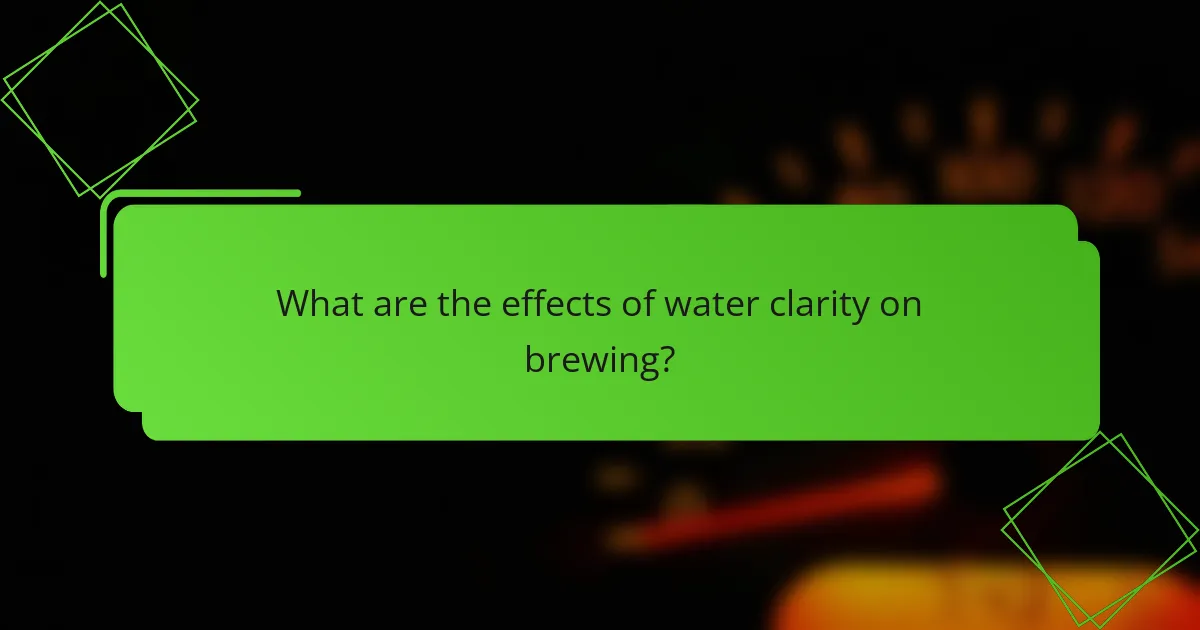Water quality plays a crucial role in determining the flavor, clarity, and overall success of brewing coffee and tea. Key factors such as mineral content, pH levels, and impurities can significantly alter the taste and visual appeal of the final beverage. To achieve optimal brewing results, it is essential to understand and manage these water characteristics effectively.

How does water quality affect flavor in coffee and tea?
Water quality significantly influences the flavor of coffee and tea, impacting both the taste and overall brewing success. Factors such as mineral content, pH levels, and the presence of chlorine can alter the final beverage’s profile, making it essential to consider water characteristics for optimal results.
Mineral content influences taste
The mineral composition of water plays a crucial role in determining the flavor of coffee and tea. Key minerals like calcium, magnesium, and sodium can enhance sweetness and body, while excessive levels of certain minerals may lead to undesirable flavors. A balanced mineral content typically ranges from 50 to 200 mg/L for optimal brewing.
For example, water with higher calcium content can improve extraction efficiency, resulting in a richer flavor profile. Conversely, water that is too soft may yield a flat taste, lacking depth and complexity.
pH levels impact acidity
The pH level of water affects the acidity of brewed coffee and tea, which is vital for flavor balance. Ideal pH levels for brewing typically fall between 6.5 and 7.5. Water that is too acidic (below 6.5) can lead to overly sour flavors, while alkaline water (above 7.5) may produce a dull or bitter taste.
When adjusting water pH, consider using additives like baking soda to raise pH or citric acid to lower it. Regular testing can help maintain the desired acidity level, ensuring a pleasant flavor experience.
Chlorine alters flavor profile
Chlorine, often used as a disinfectant in municipal water supplies, can negatively impact the flavor of coffee and tea. Even small amounts of chlorine can impart a chemical taste that overwhelms the natural flavors of the beverage. It’s advisable to use filtered or bottled water to avoid this issue.
If using tap water, letting it sit for a few hours can allow some chlorine to dissipate. Alternatively, activated carbon filters can effectively remove chlorine and other unwanted compounds, enhancing the overall flavor quality of your brew.

What are the effects of water clarity on brewing?
Water clarity significantly impacts brewing by influencing both the visual appeal and the extraction process of flavors. Clear water is generally preferred as it indicates fewer impurities, which can enhance the overall quality of the brew.
Clear water enhances visual appeal
Clear water contributes to a more visually appealing brew, making it more enticing to consumers. A clean appearance can suggest freshness and quality, which are important factors in the beverage industry.
When brewing beverages like tea or coffee, clarity can enhance the perception of flavor and aroma. Clear liquids allow for better visibility of color and texture, which can influence a drinker’s experience and satisfaction.
Particles can affect extraction
Particles in water can interfere with the extraction of flavors during brewing, potentially leading to undesirable tastes. For instance, sediment or impurities may bind with flavor compounds, reducing their availability in the final product.
Brewers should aim for water that is free from visible particles to ensure optimal extraction. Using filtered or purified water can help achieve this clarity, enhancing the overall flavor profile of the beverage.

How can water quality improve brewing success?
Water quality significantly enhances brewing success by affecting flavor, clarity, and extraction efficiency. Properly balanced minerals and controlled temperatures lead to better flavor profiles and overall brewing outcomes.
Optimal mineral balance for extraction
Minerals in water, such as calcium, magnesium, and bicarbonates, play a crucial role in the extraction process during brewing. A balanced mineral profile can enhance the solubility of flavors and aromas from the ingredients, leading to a more vibrant final product.
For instance, a calcium concentration of around 50-100 mg/L is often ideal for most brewing styles, as it promotes yeast health and improves clarity. Conversely, excessive minerals can lead to off-flavors, so it’s essential to test and adjust your water chemistry accordingly.
Temperature control with quality water
Temperature control is vital for achieving optimal extraction during brewing. Quality water helps maintain stable temperatures throughout the brewing process, which is essential for activating enzymes and ensuring proper flavor development.
A typical brewing temperature range is between 60-75°C (140-167°F), depending on the type of beverage being brewed. Using water with low mineral content can help achieve precise temperature control, reducing the risk of scorching or uneven extraction.

What are the best water sources for brewing in major cities?
The best water sources for brewing in major cities often include filtered tap water and spring water, as they can significantly influence the flavor and clarity of the final product. Selecting the right source depends on local water quality, mineral content, and personal preference.
Filtered tap water in New York
Filtered tap water is a popular choice for brewing in New York City due to its generally good quality and accessibility. New York’s municipal water supply is known for its low levels of chlorine and high mineral content, which can enhance the brewing process.
When using filtered tap water, consider investing in a quality filtration system that removes impurities while retaining essential minerals. This helps achieve a balanced flavor profile in your brew. Regular testing of water quality can ensure optimal brewing conditions.
Spring water in Los Angeles
Spring water is often favored by brewers in Los Angeles for its natural mineral composition, which can contribute to a more complex flavor profile. Many local springs provide water that is low in chlorine and rich in essential minerals, making it suitable for various brewing styles.
When selecting spring water, look for brands that specify their mineral content, as this can vary significantly. It’s advisable to choose spring water that complements the specific beer style you are brewing, as different minerals can enhance or mute certain flavors.

How to test water quality for brewing?
Testing water quality for brewing is essential to ensure the best flavor and clarity in your beverages. Key methods include measuring total dissolved solids (TDS) and checking the pH level, both of which significantly affect brewing outcomes.
Use a TDS meter for total dissolved solids
A TDS meter measures the concentration of dissolved solids in water, which can impact the taste and quality of your brew. Ideally, for brewing, TDS levels should range between 50 to 200 parts per million (ppm) to achieve a balanced flavor profile.
When using a TDS meter, simply submerge the probe in a sample of your water and read the display. Regular testing helps identify any significant changes in water quality, which can affect your brewing results.
pH test strips for acidity measurement
pH test strips are a straightforward way to measure the acidity of your water, which should ideally fall between 6.5 and 7.5 for optimal brewing. Water that is too acidic or too alkaline can lead to undesirable flavors and affect extraction efficiency.
To use pH test strips, dip the strip into a water sample and compare the color change to the provided scale. Regular monitoring will help you maintain the right pH balance, ensuring consistent brewing success.

What are the common water contaminants affecting flavor?
Common water contaminants that affect flavor include heavy metals, microbial organisms, and chemical pollutants. These impurities can alter the taste, aroma, and overall quality of beverages, particularly in brewing processes.
Heavy metals like lead
Heavy metals, such as lead, can leach into water supplies from old pipes or industrial runoff. Even low concentrations can impart a metallic taste and pose health risks, making it crucial to regularly test water sources for these contaminants.
To mitigate the effects of heavy metals, consider using water filtration systems specifically designed to remove these substances. Look for filters certified to meet NSF/ANSI standards for heavy metal reduction.
Microbial contamination risks
Microbial contamination, including bacteria, viruses, and protozoa, can significantly impact water quality and flavor. These microorganisms can cause off-flavors and may lead to health issues if consumed, particularly in brewing where sanitation is vital.
To prevent microbial contamination, ensure proper sanitation practices during water storage and handling. Regularly test water for microbial presence, especially in areas prone to contamination, and consider using UV treatment or chlorination as additional safeguards.

How does water quality vary by region?
Water quality significantly differs across regions due to variations in mineral content, pH levels, and treatment processes. These differences can greatly influence the flavor, clarity, and overall success of brewing beverages like coffee and tea.
Hard water in Chicago
Chicago is known for its hard water, which contains higher levels of calcium and magnesium. This mineral content can enhance the extraction of flavors during brewing, but it may also lead to scale buildup in equipment over time.
When brewing with hard water, consider using a water filter or a water softener to balance the mineral content. Aiming for a hardness level of around 100-200 mg/L can optimize flavor without excessive mineral buildup.
Soft water in Seattle
Seattle’s water is typically soft, with lower concentrations of calcium and magnesium. This softness can result in a cleaner taste but may lead to under-extraction of flavors in brewing processes.
To improve brewing outcomes with soft water, consider adding minerals back into the water. Aiming for a total dissolved solids (TDS) level of around 50-150 mg/L can help achieve a more balanced flavor profile in your beverages.

What are the emerging trends in water quality for brewing?
Emerging trends in water quality for brewing focus on the use of mineral-enhanced bottled water and advanced filtration systems. These methods aim to optimize flavor, clarity, and overall brewing success by tailoring water chemistry to specific beer styles.
Use of mineral-enhanced bottled water
Mineral-enhanced bottled water has gained popularity among brewers looking to improve the taste and quality of their beer. This type of water is specifically formulated with minerals like calcium, magnesium, and sulfate, which can significantly influence the brewing process and the final flavor profile.
When selecting mineral-enhanced bottled water, consider the style of beer you are brewing. For example, a pale ale may benefit from higher sulfate levels to accentuate hop bitterness, while a stout may require more calcium for a smoother mouthfeel. Always check the label for mineral content to ensure it aligns with your brewing goals.
Common pitfalls include relying solely on bottled water without understanding the impact of your local water supply. Conducting a water analysis can help you determine if additional minerals are necessary or if adjustments can be made to your existing water source. This approach can save costs and enhance the brewing process.



